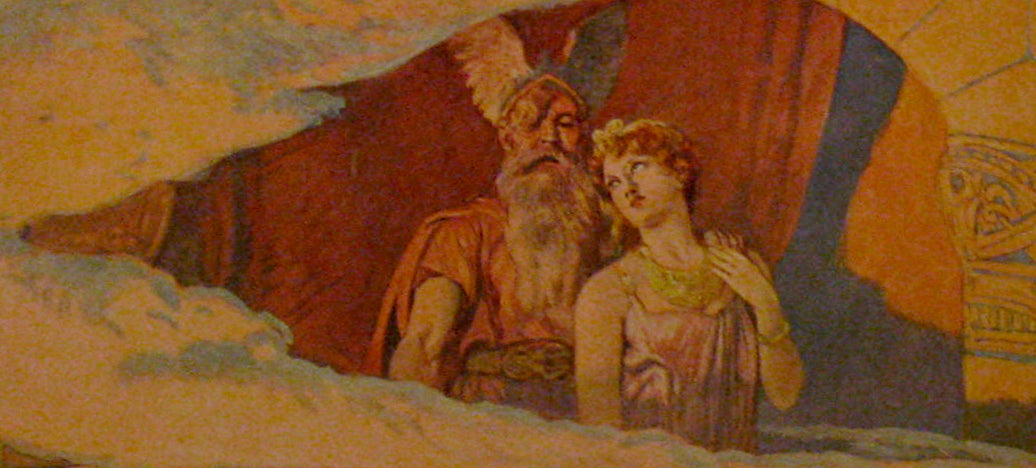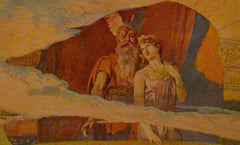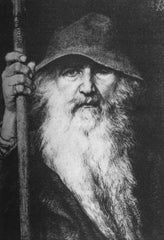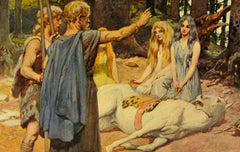on all orders over $100
on all orders over $100

In Norse Mythology Odin was the primary god amongst the Aesir clan, widely accepted to be the higher tier of Gods, who ruled the nine realms from his throne in Asgard. Often refereed to as the 'Allfather' he was an extremely complex and sometimes contradictory character who is often misunderstood and misrepresented by modern interpretations.
Some of the many descriptions of him tell us of qualities that were attributed to Odin; his wisdom, being a master of both war and poetry, and his tendency to indulge on long and self interested quests, often far from his homeland. He was also a God of war, magic, death and runes.

The modern English name itself 'Odin' is translated from the Old Norse 'Óðinn' which is the derived from the masculine form of the 'óðr' which meant 'motivation', 'enthusiasm' or 'inspiration'.
The Allfather is a character that predates the Viking Age and was recorded as far back as 12BC by Roman historians during their conquest of Germania. In addition to being one of the prominent deities in Norse Mythology Odin was also represented in Germanic Mythology, where he was known by the name 'Woden' and 'Wōdan' in Old English and Saxon. The character had a presence in the wider Germanic Mythological culture and was not unique to Norse Mythology like many of the other gods. He was often thought of as an ancestral figure and founding father of many of the Germanic tribes.
The modern English word for 'Wednesday' was derived from the Old English 'wōdnesdæg' which meant 'Woden's day'. This can also be seen in other germanic languages, the Old Norse equivalent 'Óðinsdagr' was adapted into modern Norwegian, Swedish and Danish as 'Onsdag'.
As was often the case in Norse Mythology, Odin's family tree was extremely complicated. He was born from the marriage between Burr and Bestla, a Jotun giantess. With his wife, Frigg, he had one son, the beloved Baldur.
However Odin has numerous extramarital affairs, most famously his affair with Jord, with whom he fathered another prominent Norse God, Thor. There was also speculation that Odin had an affair with Sif, who as Thor's wife, and is actually the father of their child, Ullr. Finally Odin had two other sons, named Hodr and Bragi, however it was not known who the mothers of these two were.

Odin and Freya looking down from their window - Emil Doepler, 1905
There was some uncertainty as to whether there was a relationship between Odin and Freya. There are numerous theories about the identity of Freya's husband who was referred to as 'Odr', whose name had the same meaning as Odin in Old Norse. There was also speculation that Freya and Frigg could be different names for the same character and their two stories had slowly diverged over time.
The final son of Odin was the trickster, Loki, who was not his biological son. He was born to Jotun parents, Farbautey and Laufey, however he came into Odin's care when he was a child and was raised in Asgard as one of their own.
Odin is often depicted in Modern Culture as being a strong and muscular figure, however in the Viking age his image was quite different. He was an old man, with a tall and slender build, and could often be recognised by his characteristically long beard and missing eye. His weapon of choice was the spear Gungnir which was crafted by dwarves and was said to be so well balanced that it could strike any target, regardless of the skill or strength of its bearer.
The eight-legged horse, Sleipnir, which was said to have the ability to run over air and water, is mentioned in Norse writings and was said to belong to Odin, he was also often associated with other animals such as Wolves and Ravens. Huginn and Muninn, his two raven spies, would fly over Midgard and relay information back to the Allfather.
In contrast to many all loving and forgiving Gods in other religions, Odin was often associated with war, and even seemed to revel in the violence and brutality of combat. It seems that he was largely ambivalent to the outcome of battles and would instead just enjoy the frenzied and raw bloodshed.

Odin - Georg von Rosen, 1886
In contrast to many all loving and forgiving Gods in other religions, Odin was often associated with war, and even seemed to revel in the violence and brutality of combat. It seems that he was largely ambivalent to the outcome of battles and would instead just enjoy the frenzied and raw bloodshed.
He was also described as being extremely elitist and would only give his interest to the finest warriors who had proved themselves in battle, giving little notice to the average and lesser fighters. There was a particular connection between him and the berserkers, who were fierce warriors associated with magic that would charge into battle in a trance-like state. The berserkers, like Odin, would often have spiritual associations with animals such as Bears and Wolves.
Odin was often associated with warfare and was often depicted as revelling in the chaos and violence of the battles. Whereas other gods such as Thor or Tyr were portrayed in a novel and valiant light, Odin was often described as being joyful when inciting peaceful communities into warfare. He was therefore not too concerned with the motivations for war or whether or not the cause was just, but more with the anarchic and animalistic chaos of the fighting.

Odin heals Baldur's horse - Emil Doepler, 1905
Along with Freya, Odin is one of the Norse Gods who was most referred to as a practitioner of magic and shamanism. There were numerous instances of him embarking on quests to far away realms, including the realm of the dead.
As was the case in many of the sagas in which he was featured the Poetic Edda describes how Odin's lust for knowledge lead him to make great sacrifices. In this instance he would travel to the well of Urd, which was at the base of the Yggdrasil, the tree of life. It was out of this well that Yggdrasil grew, however in its unimaginable depths there were many mysterious and powerful creatures.
A group of three female mages, known as 'the Norns' had secret knowledge of runes, which they used to carve into the trunk of Yggdrasil in order to control the destiny of the inhabitants of the nine realms.
Odin was intrigued by this powerful magic and wanted to learn the secrets of the Norns, so he travelled to the base of Yggdrasil in order to attempt to gain their knowledge. In order to demonstrate his iron will, and prove himself worthy of the power of the runes, Odin hung himself from the great tree and simultaneously impaled himself with gungnir, his magical spear, for nine whole days. During this time he refused aid from any of the other gods.
At the end of the ninth day Odin looked down into the depths of the well and saw that the runes had been revealed to him. His sacrifice has proved him to be worthy of this great knowledge and he learned not only of the form of the runes, but also of their magical properties and secret abilities. It was with this knowledge that the Allfather returned to Asgard and rules the nine realms as one of the most powerful and feared beings in the universe.
The knowledge of the runes granted Odin numerous magical abilities. According to the Poetic Edda with this new found powers he was able to raise people from the dead, heal injured soldiers, protect his allies in battle, put out fires and extinguish dark magic.
His most distinctive feature, the missing eye, has become a tell tale sign of Odin. It is thought by many modern historians that he lost the eye in a sacrifice in the pursuit of knowledge, similar to the one that he made in the pursuit of the runes.
Since the loss of an eye, being such an integral part of our bodily function, would be an extremely large sacrifice, it is only logical to presume that Odin must have gained some great knowledge or power in exchange for this great loss.
Unfortunately it is not known for sure what Odin gained in exchange for this sacrifice, as sources from this time period are scarce, and much knowledge has been lost to time. Some historians speculate that he must have gained some kind of new sense or some form of greater perception in exchange for part of his vision.
Another common name by which Odin was commonly referred to was the 'Allfather'. This was due to the fact that Odin was not only the leader of the Aesir, but also a member of the Vanir tribe under the name 'Odr'. Odin's mother was also a frost giant named 'Bestla' which made him an ancestor of many of the Gods and giants in the pantheon of Norse mythology and other Northern European pagan religions of the time period. Many kings throughout Viking age Scandinavia would claim to be descendants of Odin himself to give more authority to their royal lineage.
However although Odin was known as the 'Allfather' there were some indications in Norse literature that he may not have been as inclusive and all loving as this title would have suggested. In fact the references to Odin in many sagas would suggest that he was quite the elitist. He was often associated with the berserkers, the elite class of warrior shamans who would fight ferociously in battle whilst being linked to a 'totem' animal. Bears and wolves were usually the animals of choice for these infamous Viking warriors.
Much like the structure of the Scandinavian society itself during the early Middle Ages the Norse Gods organised themselves in a similar manner. Odin, along with some others such as Tyr, was in the top tier of the societal hierarchy which consisted of the divine rulers. Although both were feared and respected in equal measure, they had very different approaches to leadership. Tyr was more commonly associated with virtue and pragmatic rule, where as Odin was portrayed as a much more Machiavellian figure with his use of cunning and mastery of magic.
Due to this side of his character Odin was also a favoured god amongst the Outlaws and banished members of Norse society. Many of these lone wolf figures who chose to operate outside of the laws of conventional culture at the time. They identified with Odin due to his exceptionally strong will and pursuit of his goals at any cost, which often involved sacrifice, cunning and deviousness to achieve the desired ends. There were also mentions of Odin himself being banished from Asgard for a period of 10 years according to 12th Century Danish historian & author Saxo Grammaticus.
This seeming association with outcasts in addition to royalty may also have contributed to the reason for Odin being referred to as the Allfather. It appears that his favour was granted not only to those with noble status or high rank within society, but to those who were exceptionally strong willed and capable individuals, regardless of status.
There are many references to Odin's relationship with the dead, including his abilities to communicate with them and even bring them back to the living. When worthy viking warriors were slain in battle they were taken to Valhalla, a great hall in Asgard which was presided over by Odin. These slain warriors were guided to Valhalla by female spirits called Valkyries. Upon their arrival there they would become known as 'Einherjar' and would spend their days training for the final battle of Ragnarok. His motivation for choosing these elite warriors and keeping them there was in preparation for his foreseen showdown with the giant wolf Fenrir, which Odin knew he was destined to lose.
This is one reason why the Viking warriors were able to fight with such bravery and disregard for their own safety, since they believed that dying in battle was glorious and would allow them entry into Valhalla. In addition to slain warriors there were also sacrifices made to Odin, which included enemy combatants and even members of royalty. One gruesome method of sacrifice that was popular was to use the same technique that Odin allegedly used for his sacrifice to gain the knowledge of runes, namely hanging and simultaneous impaling with a spear.
If you enjoyed our article or have anything to add then please leave a comment below.
Check out some of our handmade Viking Axe designs.
1. https://historiska.se/norse-mythology/odin-en/
2. https://www.britannica.com/topic/Viking-people
3. History of the Danes, Saxo Grammaticus
4. https://www.worldhistory.org/odin/
5. Poetic Edda
6. https://norse-mythology.org/tales/odins-discovery-of-the-runes/
7. https://norse-mythology.org/gods-and-creatures/the-aesir-gods-and-goddesses/odin/
8. Prose Edda, Snorri Sturluson
9. https://en.wikipedia.org/wiki/Odin
Leave a comment